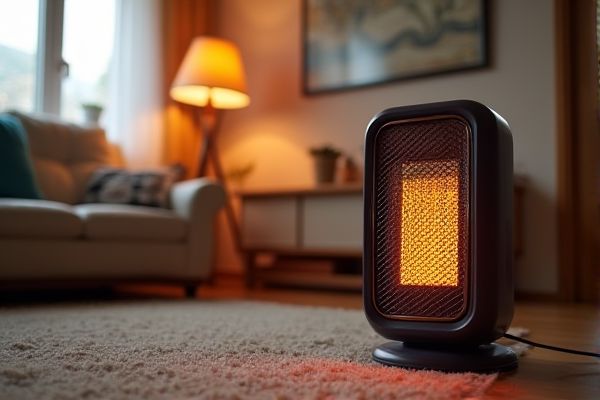
Portable heaters offer convenient, mobile warmth ideal for small spaces, while infrared heaters provide efficient, direct heat by warming objects and people rather than the air. Discover which option best matches your heating needs and lifestyle by reading the rest of the article.
Table of Comparison
| Feature | Portable Heater | Infrared Heater |
|---|---|---|
| Heating Method | Convection (warm air circulation) | Radiant heat (infrared rays) |
| Warm-up Time | Fast (minutes) | Immediate (seconds) |
| Energy Efficiency | Moderate | High (direct heating) |
| Best Use | Small rooms, personal space | Indoor/outdoor, spot heating |
| Noise Level | Some models produce noise (fans) | Silent operation |
| Safety | Risk of tipping, overheating | Cool surface, safer design |
| Portability | Highly portable, lightweight | Portable, but often heavier |
| Price Range | Low to mid-range ($20 - $100) | Mid to high-range ($50 - $200) |
Overview of Portable Heaters vs Infrared Heaters
Portable heaters typically use convection or fan-based technology to warm up air quickly in small to medium-sized spaces, offering easy mobility and immediate heat distribution. Infrared heaters emit radiant heat that directly warms objects and people rather than the air, making them energy-efficient and ideal for outdoor or drafty environments. Both types vary in power ratings, safety features, and heating methods, influencing their effectiveness depending on room size and specific heating needs.
How Portable Heaters Work
Portable heaters generate heat through electric coils or ceramic elements that warm the surrounding air, which is then distributed by a built-in fan to heat your space quickly. In contrast, infrared heaters emit radiant heat that directly warms objects and people without heating the air first, making them energy-efficient for targeted heating. Understanding how portable heaters work helps you choose the right device for efficient and comfortable warmth in your environment.
How Infrared Heaters Work
Infrared heaters emit radiant heat by using infrared light waves that directly warm objects and people, rather than heating the air like most portable heaters. This method allows for efficient, instant warmth with minimal energy loss, making infrared heaters ideal for targeted heating in both indoor and outdoor spaces. Unlike portable heaters reliant on convection, infrared technology provides consistent heat without circulating dust or allergens.
Energy Efficiency Comparison
Portable heaters typically consume more electricity by using convection to warm the air, which can lead to uneven heating and energy loss. Infrared heaters convert almost all consumed energy into heat by directly warming objects and people, resulting in higher energy efficiency and faster warmth. For your energy costs, an infrared heater offers a more economical choice with targeted and consistent heating performance.
Heating Speed and Coverage
Portable heaters typically offer faster heating speed due to their forced-air mechanisms that quickly circulate warm air throughout a room. Infrared heaters provide more efficient coverage by directly warming objects and people within their line of sight, making them ideal for focused heating zones. Your choice depends on whether you prioritize rapid space heating or targeted, energy-efficient warmth.
Safety Features and Risks
Portable heaters often include tip-over protection and overheat shutoff features to prevent fire hazards, but they still pose risks of burns and electrical issues if misused. Infrared heaters emit radiant heat that directly warms objects and people, reducing fire risk since surfaces don't reach extreme temperatures, and many models incorporate automatic shutoff sensors for enhanced safety. Both types require proper placement away from flammable materials and adherence to manufacturer guidelines to minimize safety risks effectively.
Portability and Convenience
Portable heaters typically offer lightweight designs and easy maneuverability, making them ideal for quick, flexible heating in various rooms. Infrared heaters, while sometimes bulkier due to their heating elements, provide efficient, direct warmth and are often equipped with handles or wheels for easier relocation. Both types prioritize convenience, but portable heaters excel in ease of transport while infrared heaters deliver targeted heat with moderate portability.
Cost Analysis: Purchase and Operation
Portable heaters typically have a lower upfront cost compared to infrared heaters, making them a budget-friendly option for immediate heating needs. However, infrared heaters often prove more cost-effective over time due to their energy-efficient operation, which reduces your electricity bills. Considering both purchase price and long-term energy consumption helps determine the best fit for your heating requirements.
Best Use Cases for Each Heater Type
Portable heaters excel in providing quick, adjustable warmth for small to medium-sized indoor spaces such as bedrooms, offices, and workshops, making them ideal for temporary or supplemental heating. Infrared heaters are best suited for outdoor areas or large indoor spaces where direct, targeted heating is needed, effectively warming objects and people without heating the entire air volume. Choosing between the two depends on whether fast, flexible heat or efficient, radiant warmth for specific zones is the priority.
Final Verdict: Which Heater Suits Your Needs?
Portable heaters offer versatility and easy relocation, making them ideal for temporary or spot heating in small to medium spaces. Infrared heaters deliver efficient, instant warmth by directly heating objects and people, best suited for energy-conscious users needing targeted heat without warming the entire room. Your choice depends on whether you prioritize portability and flexibility or energy efficiency and focused heating for optimal comfort.
 homyna.com
homyna.com